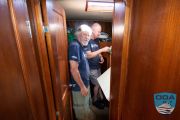By Founder and President Kurt Lieber
On this day, we figured out the answer to the following question: What do you do when the skies are bright blue and the seas are pea green? Meaning that the UW visibility was going to be like swimming through pea soup. Not conducive to keeping your dive buddy in sight, and eyes looking all around for abandoned traps…

After watching the weather predictions closely all week, despite the four-six-foot waves cresting along the beaches of southern California this past week, we saw a short window opening up on Sunday, August 7, 2022. The swells were predicted to be in the two-four-foot range. Much more to our liking.
We decided to give it a try, and seven of us met up at the boat at 8:30 in the morning with the hope of removing some abandoned lobster traps off the Ventura coast. But when we all met at the boat, we talked about all the green water we were seeing and decided to take a pass on diving.
Keep in mind for the last two weekends we’ve tried our best to get in the water and continue our work, only to give up after just one diver entered the water due to horrible UW vis (underwater visibility). It’s been less than five feet! If a trap was 10 feet away from you, you wouldn’t see it. We decided that we would be more efficient by going out on a day with better visibility.
Plan B
We then discussed if there was something we could do on the boat since everyone had already blocked out the day to go diving.
It didn’t take me long to come up with two projects that have been in the back of my mind for years.
The first one: There’s a washer and dryer on the boat, all the way in the front of the boat in the cabin, called the V-berth.
It’s in the very tip of the boat where the nose of the boat comes together. It’s a really tight spot but this washer and dryer serve us no purpose and take up valuable space. On top of that, the assembly is inoperable.
The machines are “buried” in one side of the cabin and would be a monumental pain in the butt to haul out. The doors and hallway are 20-inches wide, and the machines are 24-inches wide. We could NOT figure out how the previous owners even got it in the cabin.
After much talk about the challenge, Jeff and Mike came up with a plan. Take the thing apart! Since it was not going to come out in one piece, they took it apart panel by panel. Here you can see where they had to take it out of.
They worked on it for three hours, and piece by piece got it out of there.
Cleanup Project #2
While all that was going on, Kim Cardenas, Cristina Robinson (first time out with us!), Dave Merrill, and Geoff Walsh (not in the photo below) started getting all our tools and components better organized.
This was no small feat given that we have tools all over the cabin, and every time we need one single item, we spend an inordinate amount of time searching through toolboxes, drawers, and cabinets looking for it.
The diligent volunteers cleaned out all the hiding places, got the items in one space, and then came up with a much better system of organizing them. We now have all those tools in boxes organized and with printed labels. Now we’ll have much easier time finding all this stuff and all repair jobs will be more efficient.
Our Newest Addition & A Great Day for All
Even though this was Cristina’s first time on the boat with us, she’s been involved with ODA through an ODA project she’s been working on this year with several students at UCSB (University of California, Santa Barbara). The students are compiling debris-removal data that we’ve collected over the last 20 years. They’ll be using that data along with our Trap Trackers data (thousands of GPS locations we recorded of traps in the water) to create spatial maps that will allow them to predict the location of future debris. They’ll also be creating a short video about ODA’s impact on the ecosystem. We’ll use the materials they create in our grant requests, educational packages, and other public outreach. In addition to being able to inform the public about all the damage that’s done by ghost gear, we’ll be able to highlight all the benefits the marine ecosystem gains from ODA’s efforts to clean-up our oceans.
We're sorry Cristina didn't get to go out on the ocean and participate in a debris-removal expedition, but we were glad she got to experience the fun and camaraderie of spending time with an Ocean Defender crew! We know she'll be back to experience the satisfying feelings of being part of a team who removes hazardous debris from critical ecosystems making wildlife safer and able to thrive.
What started out as a disappointing day, turned into a VERY productive day. I was very grateful that everyone stayed and pitched in to make the boat more organized and safer to operate.
If you’re not a diver, but could see yourself helping out on the boat, please check out our Onshore Volunteer page and we’ll hope to sea you soon!


















